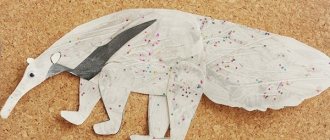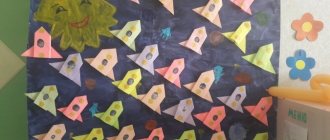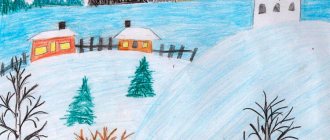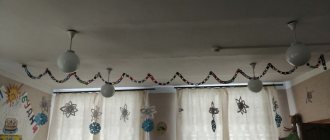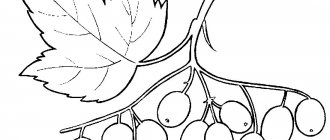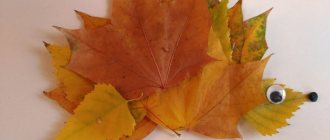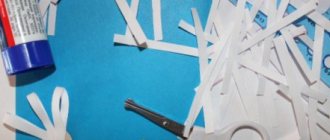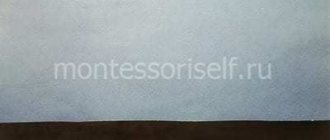A spring paper applique can convey many signs of the awakening of nature: the warmth of the sun's rays, melting snow, the murmuring of a stream, the appearance of thawed patches, the first snowdrops, even the frisky chirping of birds. Each child feels and depicts her arrival in his own way. The presented options for crafts and applications on a spring theme are suitable for creativity lovers of different ages. They will inspire new ideas and add a spring mood.
- How to make a spring applique: general recommendations
- Craft options with step-by-step instructions depending on the age of the children
- Sun applique made from palms for the little ones
- Spring tree applique made of colored paper and cardboard for kids
- Applications on paper plates for creative activities in kindergarten (senior and preparatory groups)
- Applications of spring bouquets made of colored paper
- Tulips in a vase
- Daffodils
- Dandelions
- Spring landscapes for elementary school students
- Templates
- Volume craft: spring bouquet
- Postcards with the first spring flowers
- Video: master classes from the creators of spring applications
- Photo examples of ready-made children's applications and crafts
How to make a spring applique: general recommendations
Gone are the days when the word applique meant gluing (overlaying) traditional materials onto a base: cardboard, colored paper, fabric. Now for these purposes they use: rhinestones, beads, buttons, cotton pads, leftover yarn. Often: cereals, bark, birch bark, twigs, leaves, plant seeds, etc. Due to what the picture acquires volume. When creating spring-themed applications, many of them will find a place. For example: cotton pads imitate snow, a damaged CD disc imitates the sun, and buckwheat imitates thawed patches. A non-standard approach to design adds individuality to crafts.
In addition to the above, you will need:
- Base material: disposable paper plate, cardboard, empty box, toilet paper roll (duct tape).
- Glue.
- Scissors.
- Pencil, felt-tip pens (markers).
- White and colored paper.
- Stapler.
Methods of teaching applications in the second junior group of kindergarten.
Visual activities in kindergarten
APPLICATION
2nd junior group
Application
Application
(from Latin appllcatio -
apply, apply
) - one of the types of applied art used for the artistic design of various objects (clothing, furniture, dishes, etc.) by attaching cut out decorative or thematic shapes to the main background. The originality of the applique lies both in the nature of the image and in the technique of its execution. The image in the appliqué is highly conventional compared to other types of planar images - drawing, painting. The applique is characterized by a more general form, almost without details. Most often, a local color is used, without shades, and one color is sharply different from another. The appliqué process involves two steps: cutting out individual shapes and attaching them to the background. As a means of decoration, appliqué creates a unique decorative effect. Sometimes cut-out shapes are used to decorate a room (for example, paper napkins and lace for decorating shelves, various multi-colored shapes for gluing onto glass windows as a festive decoration). Applique cut-outs from fabric, fur and leather are used to decorate clothes and make panels. Sometimes the cut out parts are not completely attached to the background, and the applique turns out to be partially voluminous. For example, the petals of a flower are attached only at the middle, and its ends lag behind the background. This gives greater expressiveness to the image. The simplicity and ease of execution of the applique make it accessible to children's creativity. Children can either use ready-made forms, painted in certain colors, or create compositions by cutting out elements of patterns, plot images, etc. Thus, applique classes contribute, on the one hand, to the formation of fine arts and skills, on the other hand, to the development of creative children's abilities.
Types of applications in kindergarten
Preschoolers master all the processes of making appliqué—cutting and gluing shapes. Preparatory exercises for mastering this type of activity are games with mosaics, with the help of which children, laying out ready-made geometric shapes, become familiar with their features, color, arrangement methods, and principles of creating a pattern. Cutting without gluing helps master the applique process (children cut paper, making tickets, flags, etc. for the game, learn to use scissors). In kindergarten, they use such types of appliqué work as gluing ready-made forms (decorative - from geometric and plant forms and object - from individual parts or silhouettes) and cutting and gluing forms (individual objects, plot, decorative). Preschoolers can cut out shapes in sections or as a silhouette. Composing an object from separate parts is easier for them, like any constructive image in drawing or modeling. Silhouette cutting is more difficult for children, since they always need to compare the general contours of the object with the proportions of its individual parts. Therefore, cutting out complex shapes is included in the program only in the preparatory group. The application contains great opportunities for the development of imagination, imagination, and creative abilities of children. Thus, the pattern can be made up of both ready-made geometric and plant shapes cut out by the children themselves. The use of ready-made forms in decorative works allows preschoolers to focus all their attention on the rhythmic alternation of elements in a pattern and the selection of beautiful color combinations. Children use the skills acquired in appliqué classes in other activities, mainly in design, making shadow theater, light decorations, and Christmas tree decorations.
Equipment
and materials for performing applique
For appliqué work, white and colored paper of various grades are used. For the background, take thicker paper - white from sketchbooks, colored table paper, thin cardboard. The forms to be glued are cut out of thin paper, preferably glossy. It comes in bright colors and is pleasant to the touch, which is especially important for working with young children. Older preschoolers also use matte colored paper of various colors and shades. If the desired shades of color are not available, the paper can be dyed. It is better to do this work not with the whole group, but with several children outside of class. Forms must be carefully prepared for classes. Geometric shapes must exactly match each other in size, which makes it possible to create a single pattern from them (for example, the side of a triangle should be equal to the side of a square or rhombus, etc.). To paste objects in the younger group, you need to prepare silhouette images or parts of the object. For classes in the middle and sometimes in the senior group, paper is cut in advance into pieces of a certain size in accordance with the task. For example, for gluing a house, they give a ready-made piece of paper representing the walls; Children cut out a roof from a strip of a different color, etc. This blank will help children maintain its shape and correctly convey the size and proportions of the parts of the house. For older preschoolers, forms of various colors and shades are used, since in these groups mainly decorative gluing is carried out from geometric shapes according to the children's plans, and they need to be provided with a wide choice of material. The use of shapes of different colors contributes to the manifestation of independence and creativity in work. Children can, if the task allows, choose the color of their choice. Particularly important is the selection of a variety of colored forms and paper in classes, the purpose of which is to independently compose beautiful color combinations. When cutting out objects, it is advisable to prepare a set of the necessary paper for each child in advance. For children in the preparatory group, all the material can be in one place. In all cases, both when gluing finished forms and when cutting, you should have more material than is necessary to complete the task. The glue is prepared from potato starch, since after it dries, no traces remain on the paper, which is very important for maintaining a neat appearance of the work. Children are given glue brushes; in older groups, hair brushes are sometimes used to apply small parts. Scissors should be small in size, with rounded ends and freely moving arms so that they can easily be moved by the child's fingers. The correctness of the created form will depend on this. Trays and flat boxes for ready-made forms, paper, scraps are placed in such quantities that it is convenient for children to use them. Each child is given an oilcloth for applying glue to the molds, a cloth and a brush stand. Such extensive equipment must be arranged so that tables are not cluttered during work. At the beginning of the lesson, only the material that will be needed at the beginning is displayed; then, as needed, new accessories are added and unnecessary ones are removed. The furnishings on the tables should remain neat and aesthetically pleasing until the end of the lesson. Thus, the application process requires a fairly large amount of materials and tools, which must be prepared in advance.
Tasks
and program material for appliqué
Learning appliqué involves familiarizing yourself with the material, acquiring the ability to cut out various shapes, arrange them on a sheet of paper in a certain order and paste them in accordance with the image and plot. The main tasks of learning applique are the following: - distinguish geometric shapes, know their names (circle, square, oval, rectangle, triangle, rhombus); -introduce primary, complementary colors and their shades, mastering the ability to create harmonious combinations; -know the sizes and quantities: large, small forms; one form is larger (smaller) than another, one, several, many forms; -develop compositional skills: rhythmically arrange identical forms in a row or alternate two or more forms; build an image depending on the shape of the sheet - on a strip, square, rectangle, circle; - create an image of an object from separate parts; -arrange objects in a plot applique. Mastering basic cutting techniques: a) cutting paper straight, along folds and by eye; b) cutting out rounded shapes by rounding corners, symmetrical shapes from paper folded in half, several times, like an accordion; c) cutting out asymmetrical shapes - silhouette and from separate parts; d) cutting along the contour; e) creating a shape by tearing off pieces of paper. Mastering basic gluing techniques (using a brush, glue, rag; the ability to sequentially glue forms). Let's consider the content of program material for different age groups. Appliqué classes begin with the second junior group ;
in the first junior group, children prepare for these activities by playing games with colored mosaics; at their own request or as shown by the teacher, they lay out the shapes in a row, alternating by color, making simple objects from them - a house, a flower, etc. In the fourth year of life, the child is able to realize his simple idea in the image, can master some technical skills. In this regard, applique is a more difficult type of activity in terms of technique than drawing or modeling, since the methods of its implementation are more complex and the result obtained is more conditional. The objectives of teaching applique in this age group are the following: familiarization with the geometric shapes that are part of many objects - a circle, a square, a triangle; knowledge of colors - red, yellow, blue, green, white, black; knowledge of the concepts of “quantity” (one, two, three, many), “size” (large, small, more, less); development of compositional skills in arranging shapes in a pattern (in a row, along the edge, in the corners) and parts of objects; mastering the skill of gluing forms. The development of motor functions of the hand in children of the fourth year of life is still imperfect, so they are not able to use scissors. True, a child can be taught this skill in a family setting. In this regard, the solution of the tasks set by the program takes place in classes with ready-made forms. Mastering the skill of making appliqué begins with gluing several shapes in one row on a strip of paper. Even this simple task requires knowledge of the features of the new pictorial form, its name and color, the ability to arrange the forms in a horizontal row, the skill of correctly applying glue and gluing the forms in the right place. So that the child can cope with this task, a circle shape is given for gluing, which is equally symmetrical along the entire contour, has no top and bottom and does not change depending on the location; to place the elements, they offer a narrow strip of paper, on which it is impossible to arrange the circles in any other way than in a row; all shapes have the same color. This makes completing the task easier: children must remember the name of the shape, its color and master the gluing technique. In the first lessons, sometimes the main difficulty for kids is the gluing process: they need to learn how to hold the brush correctly, pick up a little glue, carefully spread the form on the back side, using a special oilcloth, lay the forms in place with the smeared side, press them with a cloth, do not move them, put them down brush only on the stand. At first, the gluing technique completely absorbs the children's attention. Further complication of the program material occurs due to the introduction of circles of a different color and their arrangement in alternating colors. Then a new shape is introduced - a square. When making a composition of squares, you must ensure that they all fit exactly on one side. The composition of the appliques gradually becomes more complicated - children place and stick the shapes at the corners of the square and along the edge of the circle. These elements of the form are clearly highlighted by the form itself and are easily recognized by the child. Gluing in the center is still difficult for children in the younger group. Along with mastering the principles of the rhythmic arrangement of one or two elements, the program provides for gluing object images, first consisting of one, then of 2-3 parts (for example, a mushroom, a flag, a snowman, a house, etc.). The difficulty of these tasks is that the object and its parts must be located depending on its design: the stem of the mushroom goes down from the middle of the cap, the roof is located above the walls of the house, etc. However, kids will successfully cope with such work, since the subject tasks content is understandable to them. In addition, for the image they select objects with a symmetrical arrangement of parts, with shapes close to the geometric ones, which the children became acquainted with in the first lessons. I. L. Gusarova recommends starting appliqué work in the younger group by completing tasks that have a specific visual task - creating a familiar object. Interest in the topic will help the preschooler overcome both constructive and technical difficulties. A small child understands better the task of putting together an object from 2-3 parts than arranging geometric shapes according to the principle of alternation and symmetry in a pattern. In the first case, he himself will notice the mistakes made, since the logic of the content will be violated. The principle of alternating and repeating pattern elements will be mastered successfully when gluing flags or beads onto a drawn thread. Thus, for children of this age, each appliqué task, as well as drawing and sculpting, should be associated with a specific image. The teacher’s task is to select appropriate subject names for all decorative tasks of gluing geometric shapes - “decorate a handkerchief” (square ), “paint a plate” (circle), etc. The concept of the connection between the themes of children’s works and ideas about specific objects formed the basis of an appliqué album developed by E. E. Lootsar. All topics in it for the younger group are of a subject nature. So, the circles are glued not to a strip, but to a pre-prepared cup or saucer shape. The squares represent windows pasted onto the silhouette of the house, etc.
Methods
of teaching appliqué
in the 2nd
junior group of kindergarten
Teaching appliqué, like teaching other types of visual activities, is based on the development of children’s perceptions . Enriching their ideas about shapes, sizes, colors, and various relationships of objects in the world around them will help the work of thought and imagination during classes. Let's consider the specific features of using different teaching methods in appliqué classes in different age groups of kindergarten. Second
junior group .
For young children, material for work and the organization of the learning process are of great importance. The material for making the appliqué can be so bright that it can often distract children’s attention from the teacher’s explanations. Therefore, in the younger group, especially at first, ready-made forms for sticking are distributed to each child in a special bag after explaining the task. Children in this group are not yet able to use common material, since they do not know how to distinguish the shapes and colors of elements for gluing. After the teacher’s explanation has been heard and the forms for sticking have been distributed, the children lay them out on a sheet of paper in accordance with the assignment. The teacher checks the correct arrangement of the elements. Therefore, in the first classes in the younger group, glue is placed on the tables only after the teacher has checked all the work, immediately before the gluing process. This will allow the teacher to monitor the correct construction of the image and help children master the gluing technique. In the future, all equipment, except for color forms, can be prepared in advance. As is known, in teaching a teacher must rely primarily on the direct perception of children. Examination of an object during appliqué classes will be used to revive preschoolers’ ideas about the features of the shape, color of an object, etc. Since the image in the applique is associated with a large generalization of forms, examination of nature should be accompanied by showing samples made by the teacher, especially in the first lessons. These generalized forms of an object and their similarity to geometric ones are difficult for children to identify when examining, since they are obscured by a number of details. In the sample this shape is clearly indicated and details may be omitted. While showing the sample to the younger group, the teacher clearly names the color of the form and, if necessary, traces it with his finger, emphasizing its features. Since in the younger group the main task of teaching is to familiarize children with various forms and techniques of gluing, a sample is most often shown for exact repetition. But preschoolers should also be taught to independently solve certain problems during repeated lessons. For example, after becoming familiar with the shape of a circle and the techniques for gluing it on a strip, you can offer to choose circles of any color for gluing beads. The teacher's demonstration of work techniques is necessary to develop the correct skills in children. Moreover, the demonstration of the most complex techniques is given until the teacher is convinced that the kids have mastered them and can independently apply them in their work. The teacher also shows the sequence of the application: what form he takes, how he places it on the paper, explains at what distance from it another form should be placed, etc. After laying out, he shows and explains the gluing process if the children have not yet mastered it . The teacher accompanies each action with an explanation. The demonstration is not carried out in cases where children understand the process of laying out and gluing. The teacher, using the example, explains the task and reminds some working techniques. For children who find it difficult to complete a task, he shows these techniques individually.
Craft options with step-by-step instructions depending on the age of the children
Sun applique made from palms for the little ones
Step 1. Children place their own palms on sheets of colored paper in yellow, orange and blue. Outline them with a simple pencil. They cut it out.
Step 2. Ray-shaped palms are placed in a circle on the base.
Step 3. Draw a circle and cut it out.
Step 4. Glue all the parts to the canvas. Use a marker to draw eyes and a smile.
Spring tree applique made of colored paper and cardboard for kids
Step 1. Cut out 1 large oval from thick multi-colored cardboard, and 1 smaller circle from colored paper. Made of brown cardboard - a stripe-barrel.
Step 2. Glue a paper circle onto the large oval, then the trunk. A simple spring application for the kindergarten is ready.
If you replace the top crown blank with a cotton pad, the tree will look as if it was covered with snow.
Applications on paper plates for creative activities in kindergarten (senior and preparatory groups)
Spring primroses are one of children's favorite themes. Despite their age, children know many interesting facts about them. They talk about the characteristics of a particular species. They are having fun working on applique snowdrops on a paper plate.
Step 1. Place a paper plate on a sheet of blue paper, outline the bottom, and cut it out. Glue the resulting circle onto the inside of the plate.
Step 2. Cut out blanks from white paper that are shaped like bells with rounded petals (6 pieces). Bend them along the midline. Glue 2 parts together. This way you get 3 identical elements.
Step 3. Cut out pointed leaves from green paper. Made of white felt - a figure with smooth curves, similar to a snowdrift.
Step 4. Leaves and stems are glued to the center of the blue circle, and formed snowdrop flowers are glued to them. An improvised snowdrift is attached at the bottom.
An unusual, round panel can be given to friends, relatives or to decorate their room.
Using a similar technique, paper plates are decorated with lilacs, daffodils, tulips, and bird figures.
Applications of spring bouquets made of colored paper
Tulips in a vase
For making three-dimensional flowers, only double-sided colored paper is suitable. Tulip heads are cut out of it. To form a “book”, 6-10 identical elements are prepared. Using a stapler, they are fastened together (along the midline). Bend, straighten. It turns out to be a mini-book. As many flowers as they plan to make, so many volumetric preparations will be required.
Stems and leaves are cut out of green paper. From paper of any other color - a vase. Everything is glued onto the base.
Even more instructions on how to make such a paper flower are shown here.
Daffodils
Making a bouquet of daffodils is very simple. When forming each flower, it is enough to follow the order of the scheme:
Flowers are good in a vase and as wall arrangements.
Dandelions
Dandelions are little suns. The easiest way to make them is from paper napkins, which are available in every home. Yellow and white colors are suitable. Napkins folded into four are fastened together with a stapler, as shown in the figure:
Cut out a circle. Shallow cuts are made around the circumference. Straighten, adding volume. For stems and leaves, regular green double-sided paper will do.
Even more instructions on how to make such a paper flower are shown here.
Spring landscapes for elementary school students
To create an applique landscape, first make a sketch of the future painting on a blank sheet of paper, or select a ready-made template, which is first printed on a printer. Gradually fill the drawing with prepared materials: glue cotton wool, twigs, cereals, etc. Something that will help convey the effect of the riot of spring nature.
Looking at such works, you can’t help but feel the scent of snowdrops. You can hear the ringing of spring drops, the cry of a crane wedge.
Templates
Volume craft: spring bouquet
Step 1. Cover the tape sleeve with light green paper.
Step 2. Cut out stems and leaves of primroses from dark green paper, and flowers from white and yellow paper.
Step 3. All elements are glued to the sleeve. Decorate with braid or narrow ribbon.
You can add fluttering moths, bees, bumblebees, etc. If you put a small heavy object inside, the decorated sleeve will become a good pencil holder.
This craft is a great gift idea for any occasion.
Gifts for parents
By the way, it is not at all necessary to decorate the group with these crafts. The “Spring” applique in the second junior group can also be a wonderful gift for parents, for example, for a mother on March 8th. You just need to glue the sun, flowers, grass on which bunnies and squirrels bask, and leaves with butterflies and insects grow on the trees.
Parents always appreciate gifts from their children. Moreover, they are made by yourself! Therefore, do not forget about the spring holidays! Adults should see what their little ones have been taught and how hard they try!
Postcards with the first spring flowers
There is always room for imagination when designing postcards. Suitable for decoration: lace, openwork paper napkins, confetti, ready-made scrapbooking elements, etc. You just need to select the cardboard of the desired size and color, bend it in half and decorate the front part as you wish.
Postcards made from quilling elements turn out incredibly beautiful. Each piece is neatly rolled from a narrow strip of double-sided colored paper and has its own name. It comes in both tight and loose forms. Later, elements of different types are glued to the card, forming a design.
Panel with flowers made using the quilling technique.Collective composition
By the way, one caveat. It is better to conduct the “Applique” lesson in the second junior group as a group. Children will find it much more interesting to cut out different shapes at one table. In addition, they will learn to work together, respect the opinions of others, and make compromises.
At the same time, the application will turn out to be very original, because the kids will cut out petals of various shapes and colors - these could be red poppies, white daisies, and blue cornflowers. In a word, every child can be proud of the panoramic collective composition. In addition, the children will learn to divide colored paper, scissors, brushes, and glue.
Before starting work, you can also look at photographs, postcards and calendars with images of various flowers, talk about spring and plants, and solve riddles on this topic.
Photo examples of ready-made children's applications and crafts
Work of middle group children.
Exhibition works of children of the senior group.
Willow in a vase.
Willow branches.
For children, spring applications made from colored paper and other materials are an opportunity to express their vision of nature. Adults should respect their views and encourage creativity.
To teach your child about the seasons of the year, you will probably need instructions and guides for creating crafts in the form of “seasons”.
Forest trees
For work you need sheets of blue, green, yellow and brown paper. The parts are initially cut out from newspaper, then from colored material. For the background, blue paper is used, ideally velvet.
Dashes mark the points for the location of the cuttings. Each tree is carefully fixed one by one to the base using glue. Excess glue is removed with a napkin. For snow you will need white paper
You can decorate trees with multi-colored confetti. To ensure accurate work, you should wait until each tree dries individually. With this approach, the glue will not smear across the background.

